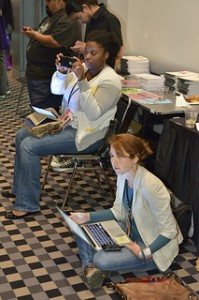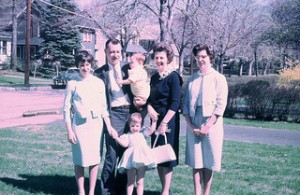If your job involves selling products or services as ours does at Prejean Creative, you likely have more than a passing acquaintance with the terms Baby Boomers and Millennials. These two demographic groups, which are separated by about 30 years, get LOTS of marketing media coverage because they are so large. “Large” translates to consumer spending, the acquisition of which can lead a marketing executive to a nice corner office in the C-suite.
The Millennials and Boomers were the focus of a June (2013) Nielsen study and to the surprise of no one they exhibit vastly different behaviors when it comes to spending their money and consuming their media. Before getting into the marketing megatrends of these mega-generations, let’s agree on a working definition of these two groups.
They Couldn’t be More Different
Nielsen notes that in the U.S., Millennials and Boomers represent roughly the same number of consumers. Baby Boomers were born between 1946 and 1964, the result of a post-World War II baby boom. These Boomers are the wealthiest generation in history, controlling 70 percent of disposable income in the U.S and they account for nearly 50 percent of all consumer packaged goods (CPG) sales, 77 percent of prescription drug sales, 80 percent of leisure travel spending and 41 percent of all new car purchases. These numbers illustrate why the demographic bulge known as Baby Boomers has been cussed and discussed by business executives in virtually every industry for the past 50+ years.
Millennials are the new kids on the demographic block. The age range of this group is 19-36. They came of age during the “Great Recession,” but, interestingly, they don’t seem to have the same financial trauma exhibited by the folks who grew up immediately after the Great Depression in the 1930s. Nielsen notes that Millennials spend 82 percent of their income and are facing large student loan repayments. The average student loan for the graduating class of 2011 was $26,600. Unlike the U.S., Millennials represent a higher percentage of the population in some developing countries. For example, in India, they compose 30 percent of the population while the Boomers represent 14 percent.
Technology Differences
Marketing people are fascinated by the rate of technology adoption by demographic groups. There’s a good reason for this. Technology is the conduit for marketing communication. The Nielsen report notes that Boomers and Millennials both have high rates of technology adoption, but “it’s how they use it that’s of interest.” Boomers are more likely to use a desktop computer, have a landline and watch traditional TV. They spend 174 hours per month watching TV (significantly more than Millennials’ 107 hours per month) and are the dominant audience in 16 of the top 25 U.S. TV shows.”
The report goes on to note that Millennials are driving technology. Seventy-six percent of Millennials own a smartphone, 73 percent own a laptop and 68 percent own a game console. However, unlike their Boomer parents, Millennials are untethered. They are less likely to have ever had a landline, are more likely to have a laptop and they watch all types of content on their phones, laptops and tablets. Interestingly, the No. 1 TV show for Boomers isn’t even in the top 30 for Millennials.
It Starts in the Brain
 The June report notes, “Real changes to the brain begin in the mid-50s when distraction suppression mechanisms are weakened,” explains the report. “But as early as the mid-40s there are severe and dramatic drops in neurotransmitter levels, dopamine and serotonin in particular. Dopamine drops lead to thrill-seeking behaviors to compensate. Serotonin drops lead to the feeling that something is missing, typical for midlife crises of career and relationship.” Well, this explains a lot!
The June report notes, “Real changes to the brain begin in the mid-50s when distraction suppression mechanisms are weakened,” explains the report. “But as early as the mid-40s there are severe and dramatic drops in neurotransmitter levels, dopamine and serotonin in particular. Dopamine drops lead to thrill-seeking behaviors to compensate. Serotonin drops lead to the feeling that something is missing, typical for midlife crises of career and relationship.” Well, this explains a lot!
This Nielsen report highlights the different tactics for dealing with these two groups. If you are a marketing or advertising director, here’s your cheat sheet.
Repetition vs. The Next Shiny Object
Boomers: The aging brain likes repetition — and will believe information that is familiar.
Millennials: Younger brains are most stimulated (better attention capture, engagement and memorability) with elements of dynamism such as rich media, lighting or rotations, to cut through their perception threshold.
Multi-tasking vs. Distraction
Boomers: The aging brain is more easily distracted — as the brain ages, it slowly loses the ability to suppress distraction.
Millennials: Millennials can equally deal with the bleeding-over communication we see in most dynamic banner ads on Web portals, while older generations need a clear-framed, separated communication to be able to engage.
Attention Span Differences
Boomers: The aging brain has a broader attention span and is open to more information.
Millennials: Younger brains have high multi-sensory processing capacity — which makes them very amenable to (and almost seek) multi-sensory communications.
Different Color Perceptions
Boomers: Contrast is the preference vs. color for online ads.
Millennials: Millennials respond better to an intense color palette for online ads.
Other Creative Considerations for the Groups
The report notes that Boomers prefer clever, light-hearted humor (rather than mean-spirited) and relatable characters who are Boomers themselves or not much younger. The tone should be positive, avoiding words like “don’t.” For Boomer males, clever wit and calm, dialogue-driven storylines work. For Boomer females, family-friendly humor and sentimental themes resonate best.
Millennials prefer offbeat, sarcastic and slapstick humor. Like Boomers, they respond to characters that are relatable to them and their life stage. Highly arresting visuals (special effects, unexpected visual elements) will best capture their attention. For Millennial males, extreme, offbeat and sports-related situations really resonate. For Millennial females, aspirational themes (female celebs, having fun) resonate strongly.
Crafting a compelling message which is delivered through effective media for maximum impact is a large part of what we do at Prejean Creative. This is made even more challenging by constant evolution and the often vast differences in perceptions in the demographic groups noted by this Nielsen study.
Boomer or Millennial? Which group is more likely to buy your product or service? Perhaps they’re both viable targets. If so, spend some time thinking about the appropriate message and media. Or better yet, just give us a call.




